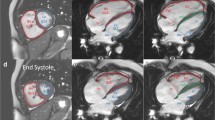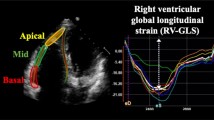Abstract
To clarify the impact on left ventricular (LV) function of percutaneous atrial septal defect (ASD) closure in adult patients. Echocardiograms of 46 patients (52 ± 18 years) who underwent ASD closure with a significant left-to-right shunt obtained before and 1 month after the procedure were retrospectively analyzed. Functional parameters were obtained by 2-dimensional speckle-tracking imaging. Global longitudinal strain and strain rate at early diastole (SRe) was calculated from the three standard apical views, while circumferential and radial parameters were calculated from basal, middle, and apical LV short-axis views. Along with a diminished right ventricular (RV) volume, the LV volume and ejection fraction increased (end-diastolic volume: 61 ± 12 to 76 ± 15 mL, p < 0.001; and 63% ± 4 to 64% ± 4% p = 0.03; respectively). Both global strain and SRe was augmented only in the circumferential direction (− 16.2% ± 2.9% to − 19.8% ± 2.8%; and 1.07 ± 0.29 to 1.34 ± 0.28 s−1, both p < 0.001). Augmentation of circumferential SRe correlated with both the changes in and the pre-procedural value of diastolic LV eccentricity index (r = − 0.57, p < 0.001; and r = 0.37, p = 0.01; respectively), a morphological parameter of RV volume overload. Following ASD closure in adults, both LV systolic and diastolic function could favorably change in the circumferential direction, and the degree of diastolic functional change is associated with RV volume overload, i.e., severity of ventricular interdependence.



Similar content being viewed by others
Abbreviations
- ASD:
-
Atrial septal defect
- E:
-
Early diastolic transmitral flow velocity
- e′:
-
Early diastolic mitral annular velocity
- LV:
-
Left ventricular
- RV:
-
Right ventricular
- SRe:
-
Strain rate at early diastole
- STE:
-
Speckle-tracking echocardiography
- 2D:
-
2-dimensional
- 3D:
-
3-dimensional
References
Lindsey JB, Hillis LD (2007) Clinical update: atrial septal defect in adults. Lancet 369(9659):1244–1246
Dickinson DF, Arnold R, Wilkinson JL (1981) Congenital heart disease among 160 480 liveborn children in Liverpool 1960 to 1969. Implications for surgical treatment. Heart 46(1):55–62
Weyman AE, Wann S, Feigenbaum H, Dillon JC (1976) Mechanism of abnormal septal motion in patients with right ventricular volume overload: a cross-sectional echocardiographic study. Circulation 54(2):179–186
Satoh A, Katayama K, Hiro T, Yano M, Miura T, Kohno M et al (1996) Effect of right ventricular volume overload on left ventricular diastolic function in patients with atrial septal defect. Jpn Circ J 60(10):758–766
Stout KK, Daniels CJ, Aboulhosn JA, Bozkurt B, Broberg CS, Colman JM et al (2019) 2018 AHA/ACC Guideline for the management of adults with congenital heart disease: a report of the American College of Cardiology/American Heart Association task force on clinical practice guidelines. Circulation 139(14):e698–e800
Kotowycz MA, Therrien J, Ionescu-Ittu R, Owens CG, Pilote L, Martucci G et al (2013) Long-term outcomes after surgical versus transcatheter closure of atrial septal defects in adults. JACC Cardiovasc Interv 6(5):497–503
Pascotto M, Santoro G, Caso P, Cerrato F, Caso I, Caputo S et al (2005) Global and regional left ventricular function in patients undergoing transcatheter closure of secundum atrial septal defect. Am J Cardiol 96(3):439–442
Giardini A, Donti A, Formigari R, Specchia S, Prandstraller D, Bronzetti G et al (2004) Determinants of cardiopulmonary functional improvement after transcatheter atrial septal defect closure in asymptomatic adults. J Am Coll Cardiol 43(10):1886–1891
Ewert P, Berger F, Nagdyman N, Kretschmar O, Dittrich S, Abdul-Khaliq H et al (2001) Masked left ventricular restriction in elderly patients with atrial septal defects: a contraindication for closure? Catheter Cardiovasc Interv 52(2):177–180
Lange A, Coleman DM, Palka P, Burstow DJ, Wilkinson JL, Godman MJ (2003) Effect of catheter device closure of atrial septal defect on diastolic mitral annular motion. Am J Cardiol 91(1):104–108
Masutani S, Taketazu M, Mihara C, Mimura Y, Ishido H, Matsunaga T et al (2009) Usefulness of early diastolic mitral annular velocity to predict plasma levels of brain natriuretic peptide and transient heart failure development after device closure of atrial septal defect. Am J Cardiol 104(12):1732–1736
Lim DS, Gutgesell HP, Rocchini AP (2014) Left ventricular function by pressure-volume loop analysis before and after percutaneous repair of large atrial septal defects. J Interven Cardiol 27(2):204–211
Mor-Avi V, Lang RM, Badano LP, Belohlavek M, Cardim NM, Derumeaux G et al (2011) Current and evolving echocardiographic techniques for the quantitative evaluation of cardiac mechanics: ASE/EAE consensus statement on methodology and indications endorsed by the Japanese Society of Echocardiography. J Am Soc Echocardiogr 24(3):277–313
Wang J, Khoury DS, Thohan V, Torre-Amione G, Nagueh SF (2007) Global diastolic strain rate for the assessment of left ventricular relaxation and filling pressures. Circulation 115(11):1376–1383
Pieper GM, Shah A, Harmann L, Cooley BC, Ionova IA, Migrino RQ (2010) Speckle-tracking 2-dimensional strain echocardiography: a new noninvasive imaging tool to evaluate acute rejection in cardiac transplantation. J Heart Lung Transplant 29(9):1039–1046
Akagi T (2015) Current concept of transcatheter closure of atrial septal defect in adults. J Cardiol 65(1):17–25
Baumgartner H, Hung J, Bermejo J, Chambers JB, Evangelista A, Griffin BP et al (2009) Echocardiographic assessment of valve stenosis: EAE/ASE recommendations for clinical practice. J Am Soc Echocardiogr 22(1):1–23; quiz 101–102
Zoghbi WA, Adams D, Bonow RO, Enriquez-Sarano M, Foster E, Grayburn PA et al (2017) Recommendations for noninvasive evaluation of native valvular regurgitation: a report from the American Society of Echocardiography developed in collaboration with the Society for Cardiovascular Magnetic Resonance. J Am Soc Echocardiogr 30(4):303–371
Nagueh SF, Smiseth OA, Appleton CP, Byrd BF 3rd, Dokainish H, Edvardsen T et al (2016) Recommendations for the evaluation of left ventricular diastolic function by echocardiography: an update from the American Society of Echocardiography and the European Association of Cardiovascular Imaging. J Am Soc Echocardiogr 29(4):277–314
Leitman M, Lysyansky P, Sidenko S, Shir V, Peleg E, Binenbaum M et al (2004) Two-dimensional strain-a novel software for real-time quantitative echocardiographic assessment of myocardial function. J Am Soc Echocardiogr 17(10):1021–1029
Takigiku K, Takeuchi M, Izumi C, Yuda S, Sakata K, Ohte N et al (2012) Normal range of left ventricular 2-dimensional strain: Japanese Ultrasound Speckle Tracking of the Left Ventricle (JUSTICE) study. Circ J 76(11):2623–2632
Rudski LG, Lai WW, Afilalo J, Hua L, Handschumacher MD, Chandrasekaran K et al (2010) Guidelines for the echocardiographic assessment of the right heart in adults: a report from the American Society of Echocardiography endorsed by the European Association of Echocardiography, a registered branch of the European Society of Cardiology, and the Canadian Society of Echocardiography. J Am Soc Echocardiogr 23(7):685–713; quiz 786-8
Gao CH, Zhang H, Chen XJ (2010) The impacts of transcatheter occlusion for congenital atrial septal defect on left ventricular systolic synchronicity: a three-dimensional echocardiography study. Echocardiography 27(3):324–328
Bussadori C, Oliveira P, Arcidiacono C, Saracino A, Nicolosi E, Negura D et al (2011) Right and left ventricular strain and strain rate in young adults before and after percutaneous atrial septal defect closure. Echocardiography 28(7):730–737
Cai QZ, Liang Y, Zhu ZH, Lu XZ (2014) Influence of percutaneous atrial septal defect closure on inter- and intra-ventricular mechanical dyssynchrony in adults: evaluation of strain pattern. Int J Cardiovasc Imaging 30(4):721–727
Pascotto M, Santoro G, Cerrato F, Caputo S, Bigazzi MC, Iacono C et al (2006) Time-course of cardiac remodeling following transcatheter closure of atrial septal defect. Int J Cardiol 112(3):348–352
Dahle GO, Stangeland L, Moen CA, Salminen PR, Haaverstad R, Matre K et al (2016) The influence of acute unloading on left ventricular strain and strain rate by speckle tracking echocardiography in a porcine model. Am J Physiol Heart Circ Physiol 310(10):H1330–H1339
Acknowledgements
This research was not supported by grants from any funding agencies in the public, commercial, or not-for-profit sectors.
Author information
Authors and Affiliations
Contributions
All authors contributed to study conception and design. Methodology: TM, TY, MY; Data collection and analysis: TM, TY, MY; Writing—original draft preparation: TM, TY; Writing—reviewing and editing: TY, SM; All authors read and approved the final version.
Corresponding author
Ethics declarations
Conflict of interest
The authors declare that they have no conflicts of interest.
Informed consent
All study subjects provided written informed consent.
Additional information
Publisher’s Note
Springer Nature remains neutral with regard to jurisdictional claims in published maps and institutional affiliations.
Rights and permissions
About this article
Cite this article
Miki, T., Yamano, T., Yamano, M. et al. Favorable changes of left ventricular function in the circumferential direction following transcatheter atrial septal defect closure: a strain imaging study. Int J Cardiovasc Imaging 37, 903–912 (2021). https://doi.org/10.1007/s10554-020-02064-4
Received:
Accepted:
Published:
Issue Date:
DOI: https://doi.org/10.1007/s10554-020-02064-4




